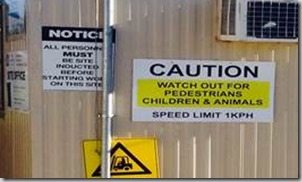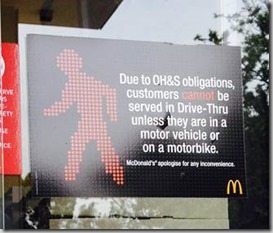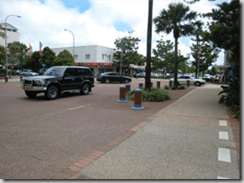This Toaster is Hot
Warning, please stop and “Take Five”!
Guest Post by Rob Sams – inspired by this “Hot Toaster” page
 Before you read any further, I feel compelled to warn you that reading this article may be harmful for your health, it may even cause an injury. I have no idea how or why, but I’m so concerned for your health and safety, after all, it’s my number one priority, that I want to make sure I do everything I can, to protect you from injury.
Before you read any further, I feel compelled to warn you that reading this article may be harmful for your health, it may even cause an injury. I have no idea how or why, but I’m so concerned for your health and safety, after all, it’s my number one priority, that I want to make sure I do everything I can, to protect you from injury.
If you have chosen to read on, you must be a risk taker, and now that I know that, I also know that you like to learn, and learning is something that is important for health and safety. More important I believe than safety than signs and ridiculous warnings like in the paragraph above.
It seems that everywhere you look these days there is a sign or notice warning about the dangers of life. For example I was walking in a side street in a busy Sydney suburb with a colleague just last week and we took this photo:
This was in the middle of a public street that was used by perhaps 50 or so people an hour during the day. As we walked, we had no idea of the potential dangers we faced. We could have knocked our leg on the tap or worse; we could have stopped in the middle of the street, got down on our knees and drank the water.
We were so grateful to the local Council. They had thankfully been very diligent in their risk assessment and placed a protective white barrier around the tap, and a very helpful sign which prevented us from even thinking about drinking the rainwater.
The irony of course is that we felt that the white barrier sticking out around the tap actually created a greater hazard than they tap itself, but I thought, at least the Council were able to fill out the “Control” section of their risk assessment form.
This reminded me another sign in the photo below that I saw on a construction site in Canberra earlier this year:
This was the site office for the construction site which was in the middle of a major sporting complex that was completely fenced off and locked. The site was being refurbished and only accessed by authorised people doing the construction. It was an in industrial area where there were no houses and no schools. After reading the sign, I was very vigilant and kept my eyes open for any pedestrians, children and animals all the time while I was on the site. I don’t know why I was being cautious about them, but I just knew I needed to keep an eye out for them.
I must admit though, I did struggle with the other safety instruction, walking at 1KPH was tough, there was at least three occasions that my site contact pulled me up and asked me to slow down, he said that I was walking at least 5KPH. He issued me with a formal warning that if I exceeded the speed limit one more time, I would be banned from the site. They take safety very seriously at that site.
These are just two examples, there are so many more. How about these classics:
- “This Toaster is Hot” label on the all toasters in lunch rooms
- “This Water is Hot” sign on the Zip water boiling system in the lunch room or;
- The classic in the photo below from a well known fast food outlet below:
The prevalence of these types of signs, is so incredible, that a blog has been started (https://safetyrisk.net/this-toaster-is-hot/) so we can all keep up to date with these very important safety messages. How could we live our life safely if we don’t know these things?
I’m sure the day will come, it’s not far away, where toast will be banned at work, we will drink luke warm tea, and nail guns (see http://m.canberratimes.com.au/queensland/what-can-happen-when-a-man-gets-a-nail-gun-for-christmas-20131217-2ziux.html), gone!
We seem so driven by fear in modern society that our approach to safety seems to be to warn everyone of everything. Don’t take any risk, don’t leave any stone unturned, if there is a potential danger make sure we warn people. Signs, signs and more signs, the more the better!
I wonder whether some people in workplaces look at the “reasonably practical” requirements of modern day health and safety legislation and think, “well if we place warning signs around the place, we will be able to demonstrate that we did all we could”. Workplaces who take this approach need to think carefully about the impact of flooding employees with information and the limits of our bounded rationality (see – http://en.wikipedia.org/wiki/Bounded_rationality)
It reminds me of a story by the team on the ABC show The Checkout (developed by the Chaser team). In one particular show (http://www.youtube.com/watch?v=uTfmiCkdylE), they talk about the 24 pages of Terms and Conditions for iTunes. Does anyone really read through all 24 pages before clicking “I Agree”. If you did, do you really know what you have signed up for?
The danger of course with so many signs and safety warnings in our workplaces is that by trying to warn everyone of everything, we may actually warn no one of anything!
If we dumb down safety so much that people don’t take it seriously? Will the result be that they switch off? Worse still, will our warnings about what we should do to be safe become so ridiculous that they can’t be taken seriously? Will people become blinded to the signs? Maybe they will take notice of them the first time, but after that, will they fade into the background? Worse, if the signs are filled with ridiculous advice such as a toaster being hot, will this encourage people to not read any of our signs at all as they may feel belittled by our approach?
As an alternative, perhaps we should take a leaf out of the city of Port Macquarie on the mid North Coast of NSW. In main CBD area of Port Macquarie there are very few street signs. In the photo below, you will see no pedestrian crossings and no Stop signs.
(photo courtesy of Human Dymensions, see www.humandymensions.com)
I remember a recent trip to the area to see friends. We were walking with their young kids along the streets and became very alert to the traffic around us. We weren’t sure who had the right of way, should the car stop or should we? The end result was that we made eye contact with the driver of the car. By doing this, we communicated with each other about who would stop, and away we went.
Could the impact of having no or little street signs be that we were safer? Could it be that because there was nothing to guide us as to what was safe, we had to consciously stop and think about it? Could it be that drivers in the area drove just that bit slower because they couldn’t be sure if people were going to walk into their path or not?
I wonder if we took the same approach to warnings about safety in the workplace whether this would lead to the same sort of actions?
This is the quagmire faced by the modern day safety professional.







Do you have any thoughts? Please share them below